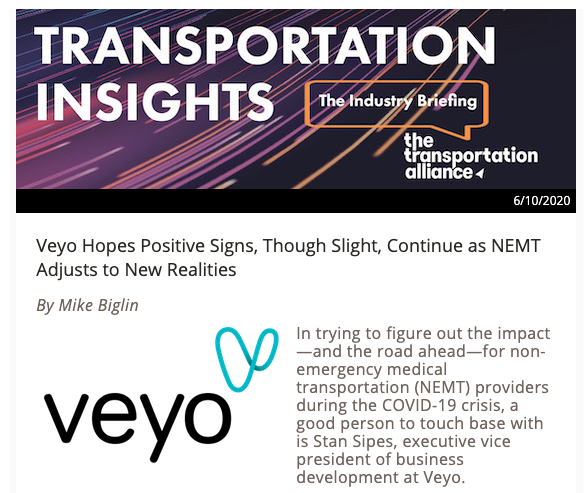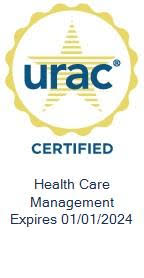Stan Sipes Featured on the Transportation Alliance Discussing COVID and NEMT
June 16, 2020
Veyo was recently featured in the Transportation Alliance with an interview of our EVP of Business Development, Stan Sipes. Stan spoke on the effects of COVID-19 in the non-emergency medical transportation (NEMT) space and what to expect as the country begins to reopen following the pandemic. The article can be found here and is reprinted below.
——-
Veyo Hopes Positive Signs, Though Slight, Continue as NEMT Adjusts to New Realities By Mike Biglin
In trying to figure out the impact—and the road ahead—for non-emergency medical transportation (NEMT) providers during the COVID-19 crisis, a good person to touch base with is Stan Sipes, executive vice president of business development at Veyo.
The San Diego, Calif., based company is a prominent member of The Transportation Alliance, providing NEMT brokerage services to Managed Care and state agencies in six states. Pre-pandemic days, they were managing some 34,000 trips daily. But those numbers have fallen since the virus hit the United States, like all transportation usage worldwide.
“What we saw, as well as what the industry saw, was a significant slide,” Sipes said. “When you saw health care providers cut back to critical care only, or begin to move to telehealth, there was a natural degradation of anywhere from 30-to-50 percent of trips just no longer being necessary through NEMT.”
Veyo currently manages contracts for customers in Arizona, Connecticut, Virginia, Florida, Michigan, and California. When Arizona was one of the first states to ease lockdown situations, Veyo was curious as to what the impact might be on NEMT utilization, and early results have shown a promising increase in trip numbers.
“We are beginning to see an uptick as the healthcare providers expand their in-office services, which started in early May,” Sipes said. “Arizona was one of the first states that officially began to reopen, and to some extent all states are beginning to take steps to lessen the restrictions to the stay-at-home restrictions. While we have seen an uptick in most markets, it is tough to predict what NEMT utilization will look like over the next few months and into 2021.
“Will volumes get back to pre-COVID numbers? I don’t think anyone really knows at this point,” Sipes continued. “With the introduction and expansion of telehealth, there will be a shift in how people access healthcare. However, there are several aspects of healthcare that still require in-person care and NEMT.”
Sipes cautioned that any reports coming out of Arizona that trip counts are already at pre-COVID levels are simply untrue. But he also sees other NEMT-related opportunities.
“Arizona is experiencing an increase, but certainly not near the pre-COVID time. We are watching our data daily, and preparing for whatever the situation requires. Like I said, anybody’s crystal ball is as legitimate right now as anyone else’s.”
So Sipes and his Veyo mates are trying to peer into the future to see what it holds. They feel one thing that should rise is a new demand to use logistical services to support the “new normal.” Veyo, said Sipes, already sees NEMT having to provide more flexible solutions as health systems face a growing need to meet their patients in their communities and homes. As an example, they have created a specialized fleet of drivers and vehicles that are able to provide COVID+ patients NEMT transport to critical care. It took an amazing amount of collaboration between Veyo, their customers and the regulators to put this together, and it is likely that this service will be of value beyond the current crisis.
“We’re calling this a trend toward ‘Reverse NEMT.’ Instead of delivering the patient to their healthcare services, NEMT will need to adapt to move healthcare services to the patient,” he said. “Delivering goods to DME (Diabetic Macular Edema), pharmacy and food to patients … as well as supporting telehealth with logistical services. Not every patient has telehealth capability, so that might be an opportunity for an organization to deliver that technology and support, whatever it may be.”
Sipes also pointed out the movement toward increased in-home treatments for everything from dialysis to substance abuse, and how that could open up the opportunity for transporting equipment, and possibly healthcare professionals, to patient homes. No matter the situation, Sipes believes – now more than ever – it’s vital for NEMT providers to innovate with the changing times ahead.
“There are going to be some great opportunities to come out of this crisis for those who are able to pivot. Necessity is the seed of innovation, after all. Some are going to do it; some aren’t,” said Sipes.
Sipes said he’s paying daily attention to what he’s hearing from other NEMT providers in the Alliance. “Each one has their stories, and some organizations figure out a way to directly serve organizations–we can learn from that,” he said.
“In the NEMT business, you got providers in the TTA as small as two and as big as hundreds [of vehicles]. Each one has a unique story, and some are heavily dependent on brokers.”
He has heard about some providers seeing a significant drop in their business, while others had to only cut back a little, “or they found new opportunities and pivoted to provide additional amounts of services. So we caution ourselves that there’s a general feeling of unease within our industry.”
Sipes admits that he and Veyo are hoping the recent uptick continues northward, but that they are preparing for whatever the future holds.
“The increases in May appears to be continuing, but whether or not that continues, or plateaus, remains to be seen,” he said. “A lot depends on (the possible COVID-19) second wave, and what happens if that hits.”
“There are so many external dependencies, like do healthcare providers continue using telehealth? Will the methadone treatment process, where instead of a patient going in daily to get their dose, some have been giving patients the option to receive a week or couple weeks of doses, continue beyond the crisis?”
As Sipes said, right now it’s a time to prepare and be sure that opportunities are not missed. He’s working hard to make sure Veyo is on that path.
“We literally designed a technology platform, a vertically integrated platform, designed for NEMT management,” he said. “In addition to our fleet of professional drivers who meet requirements of every state, they also utilize our technology that lets them know what each patient needs. We feel those tools have us ready to face any challenges ahead.”
Want to learn more about our efforts in Arizona?
Download our latest white paper: Ridesharing in NEMT.


